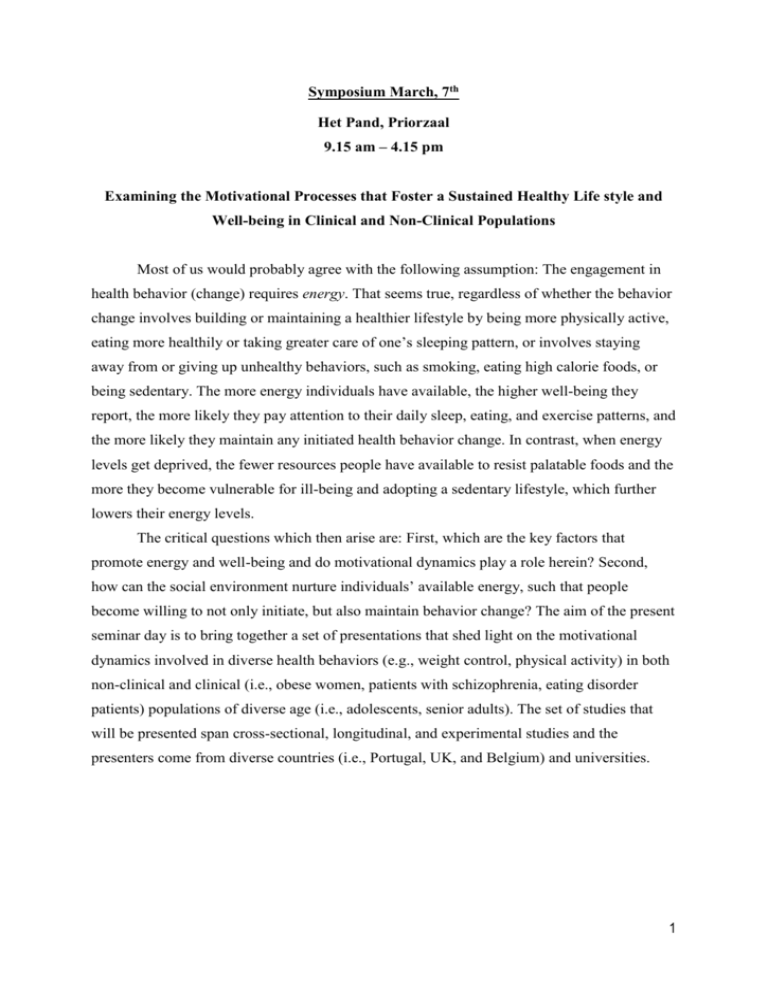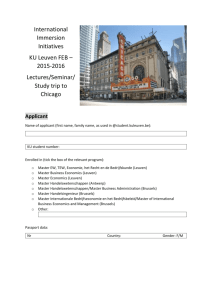View/Open - Lirias
advertisement

Symposium March, 7th Het Pand, Priorzaal 9.15 am – 4.15 pm Examining the Motivational Processes that Foster a Sustained Healthy Life style and Well-being in Clinical and Non-Clinical Populations Most of us would probably agree with the following assumption: The engagement in health behavior (change) requires energy. That seems true, regardless of whether the behavior change involves building or maintaining a healthier lifestyle by being more physically active, eating more healthily or taking greater care of one’s sleeping pattern, or involves staying away from or giving up unhealthy behaviors, such as smoking, eating high calorie foods, or being sedentary. The more energy individuals have available, the higher well-being they report, the more likely they pay attention to their daily sleep, eating, and exercise patterns, and the more likely they maintain any initiated health behavior change. In contrast, when energy levels get deprived, the fewer resources people have available to resist palatable foods and the more they become vulnerable for ill-being and adopting a sedentary lifestyle, which further lowers their energy levels. The critical questions which then arise are: First, which are the key factors that promote energy and well-being and do motivational dynamics play a role herein? Second, how can the social environment nurture individuals’ available energy, such that people become willing to not only initiate, but also maintain behavior change? The aim of the present seminar day is to bring together a set of presentations that shed light on the motivational dynamics involved in diverse health behaviors (e.g., weight control, physical activity) in both non-clinical and clinical (i.e., obese women, patients with schizophrenia, eating disorder patients) populations of diverse age (i.e., adolescents, senior adults). The set of studies that will be presented span cross-sectional, longitudinal, and experimental studies and the presenters come from diverse countries (i.e., Portugal, UK, and Belgium) and universities. 1 Content & time table MORNING SESSION 9.15-9.45: Meet & greet with coffee 1. 9.45-10.45: Invited speaker: Pedro Teixeira (University of Lisboa, Portugal). Selfdetermined motivation and weight control 2. 10.45-11.10: Filip Boen, An-Sophie Van Hoecke, & Norbert Vanbeselaere (University of Leuven, Belgium). Targeting the personal and social self: Year-round effectiveness of identity-based physical activity promotion among sedentary older adults. 11.10-11.30: Coffee break 3. 11.30-11.55: Davy Vancampfort, Marc De Hert, Maarten Vansteenkiste, & Michel Probst (University of Leuven, Belgium). Being autonomously motivated towards an active lifestyle: an utopia in persons with schizophrenia? 4. 11.55-12.20: Jolene Van der Kaap-Deeder, Maarten Vansteenkiste, Bart Soenens, Liesbet Boone, Joke Verstuyf, and Jos Smets. Fostering Self-Endorsed Motivation to Change in Patients with an Eating Disorder: The Role of Perceived Autonomy Support and Psychological Need Satisfaction 12.20-13.30: Lunch break AFTERNOON SESSION 5. 1.30-2.30: Invited speaker: Helga Dittmar (University of Sussex, UK). What is the impact of consumer culture values on well-being: Evidence from meta-analytic, longitudinal and experimental studies. 6. 2.30-2.55: Lien Goossens, Caroline Braet, Kim Van Durme, & Guy Bosmans (Gent University, Belgium). The impact of experimental exposure to thin media images on preadolescents’ body dissatisfaction and eating behavior. 2.55-3.15: Coffee break 7. 3.15-3.40: Cindy Rutten, Filip Boen, & Jan Seghers (University of Leuven, Belgium). Motivational and environmental predictors of physical activity during the transition from elementary to secondary school: A self-determination and social-ecological approach 8. 3.40-4.05: Maarten Vansteenkiste, Beiwen Chen, Bart Soenens, Wim Beyers, & Jasper Van Assche (Gent University, Belgium). New Evidence on the Essential Role of Psychological Need Satisfaction 4.05-4.15: Closing comments 2 Abstracts MORNING SESSION 1. Invited speaker: Self-determined motivation and weight control Pedro Teixeira University of Lisboa (Portugal) The present chronic disease model of health and health care puts a high burden on long-term behavioral self-regulation by individuals. Paradoxically, interventions aimed at promoting individual and sustained health behavior change, in areas such as diabetes, obesity, and physical activity, have not been sufficiently successful. One reason could be that models and theories underlying (or inspiring) the majority of these interventions were not developed to explain the integration of new behavioral patterns with people’s values, lifestyles, and routines (i.e. behavior change). Providing a detailed and qualitative analysis of motivational dynamics, self-determination theory explains why and how people can develop ownership over, assume responsibility for, and effectively self-regulate particular behaviors patterns in a sustained way, if that’s their reflected choice. It also provides guidance to design behavior change interventions, based on the relation between the level of psychological need satisfaction, the goals sought by the behavior, and the nature of the motives underlying it. In this presentation, a 1-year group intervention for overweight women based on selfdetermination theory will be described, and 3-year results for body weight and key motivational and behavioral outcomes, including different forms of physical activity (including “non-sedentary behaviors”), will be presented. The discussion will focus on theorybased mechanisms by which the intervention produced its long-term results, on the motivational underpinnings of lasting (autonomous) behavior change in the area of weight control, and on implications for future interventions. 3 2. Targeting the personal and social self: Year-round effectiveness of identity-based physical activity promotion among sedentary older adults Filip Boen, Ann-Sophie Van Hoecke & Norbert Vanbeselaere KU Leuven, Belgium Purpose: To evaluate the year-round effectiveness of three identity-based physical activity counseling procedures among older adults. Methods: In a personal identity condition (PI), participants’ personal self was targeted by Physical Activity (PA) coaching based on the Self-Determination Theory. A Health Fitness Specialist (HFS) explicitly fostered the needs for autonomy, competence and relatedness at a personal level during weekly contact. In a social identity condition (SI), a HFS targeted, weekly, participants’ social self by PA coaching according to the Self-Categorization Theory. Participants’ physical activity behavior was facilitated by postulating social-identity based normative support for physical activity (i.e. by advancing physical activity as prototypical of a relevant social identity). In an integrated identity condition (II), a HFS targeted both the participants’ personal and social self during weekly contact. Sedentary adults aged 55 to 70 years (n = 169) completed measurements on physical activity and autonomous forms of motivation before the six-week intervention (pre-test), immediately after the intervention (post-test), and one year after the start of the intervention. Results: Linear mixed models demonstrated significant and large (+ 60%) increases from pre- to post-test in daily steps and self-reported physical activity in PI, SI and II, with no differences in changes over time between the interventions. Moreover, the pre- to follow-upincreases remained significant and large, suggesting that all three interventions were equally effective in changing participants’ physical activity behaviour. Conclusion: Targeting the personal or/and social identity among older adults appears to be effective in increasing their physical activity in the long run. 4 3. Being autonomously motivated towards an active lifestyle: An utopia in persons with schizophrenia? Davy Vancampfort1,2, Marc De Hert1, Maarten Vansteenkiste3, Michel Probst1,2 1 KU Leuven Department of Neurosciences, UPC KU Leuven campus Kortenberg, Kortenberg, Belgium 2 KU Leuven Department of Rehabilitation Sciences, KU Leuven, Leuven, Belgium 3 Department of Psychology, Ghent University, Ghent, Belgium Background: There is a need for theoretically-based research on the motivational processes linked to the commencement and continuation of physical activity in patients with schizophrenia. Aims: We investigated the self-determination tenets in patients with schizophrenia by examining the factor structure of the Behavioral Regulation in Exercise Questionnaire-2 (BREQ-2) and by investigating associations between motives for being physically active and physical activity participation. Methods: A total of 129 (44♀) persons with schizophrenia completed the BREQ-2 and the International Physical Activity Questionnaire (IPAQ). Results: Exploratory factor analysis showed sufficient convergence with the original factor for amotivation, external and introjected regulation, while identified and intrinsic regulations loaded on a single factor which we labeled “autonomous regulation”. Significant positive correlations were found between the total IPAQ score and the subscales amotivation (r=-0.44, p<0.001), external regulation (r=-0.27, p<0.001), and autonomous regulation (r=0.57, p<0.001). Outpatients reported more external (p<0.05) and introjected (p<0.05) regulations than inpatients. Discussion: The current findings suggest that patients’ level of self-determination may play an important role in the adoption and maintenance of health promoting behaviors in patients with schizophrenia. 5 4. Fostering Self-Endorsed Motivation to Change in Patients with an Eating Disorder: The Role of Perceived Autonomy Support and Psychological Need Satisfaction Jolene Van der Kaap-Deeder, Maarten Vansteenkiste, Bart Soenens, Liesbet Boone, Joke Verstuyf, and Jos Smets* University of Gent, Belgium * Broeders Alexianen, Tienen, Belgium Objective: Although several studies have established the beneficial effects of self-endorsed forms of motivation for lasting therapeutic change, the way patients with an eating disorder can be encouraged to volitionally pursue change has received less attention. On the basis of Self-Determination Theory, this longitudinal study addressed the role of an autonomysupportive environment and psychological need satisfaction in fostering self-endorsed motivation for change and subsequent weight gain. Method: Female inpatients (n = 84) with mainly anorexia nervosa and bulimia nervosa filled out questionnaires at the onset of, during, and at the end of treatment regarding their perceived autonomy support from parents, staff members, and fellow patients, their psychological need satisfaction, and their reasons for undertaking change. Furthermore, the Body Mass Index (BMI) of the patients at the onset and end of treatment was assessed by the staff. Path analyses were used to investigate the relations between these constructs. Results: At the start of treatment, perceived parental autonomy support related positively to self-endorsed motivation through psychological need satisfaction. Perceived staff and fellow patients autonomy support related to changes in self-endorsed motivation over the course of treatment through fostering change in psychological need satisfaction. Finally, relative increases in self-endorsed motivation related to relative increases in BMI throughout treatment in a subgroup of patients with anorexia nervosa. Discussion: These results point to the importance of an autonomy-supportive context for facilitating self-endorsed motivation. 6 AFTERNOON SESSION 5. Invited speaker: What is the impact of consumer culture values on well-being: Evidence from meta-analytic, longitudinal and experimental studies Helga Dittmar, UK Abstract: Being rich, having the 'right things' and 'looking good' with a perfect body shape are core values that are highly profiled in current consumer culture. What is the psychological impact when individuals internalised these materialistic and appearance-focused ideals as their own personal values? This talk presents findings from multiple studies on the nature of the relationship between a consumer culture value orientation and different facets of wellbeing. Two meta-analyses show, respectively, that materialist values are linked to significantly lower personal well-being and to less environmentally friendly attitudes and behaviours in adults. A series of studies in the UK and Hong Kong with primary school children shows that materialism undermines children's school performance through impacting their learning motives. A longitudinal study with over 2000 8-14-year-old children examines the likely causal links between consumer culture values and personal well-being, and addresses SES and identity-related processes as moderator and mediator of these links. 7 6. The impact of experimental exposure to thin media images on preadolescents’ body dissatisfaction and eating behavior Lien Goossens, Caroline Braet, Kim Van Durme, & Guy Bosmans University of Gent, Belgium University of Leuven, Belgium Awareness has recently grown regarding the prevalence of body image problems and disordered eating behaviors in preadolescents. Although to a certain degree body dissatisfaction can be considered normative, these feelings can have serious consequences such as low self-esteem, depression, eating disorders and obesity. From a socio-cultural perspective, society’s current unrealistic beauty standards reinforce the desire for being thin, which is accepted and internalized by girls, but almost impossible to achieve. This current unrealistic thin ideal is reinforced by different environmental influences such as peers, school, parents, but the most aggressive purveyors of these unrealistic thin images appear to be the mass media. The aim of the present study was to investigate changes in body dissatisfaction and eating behavior in a sample of 9-13 year old preadolescents following exposure to either images of thin, idealized people (experimental condition) or images of average size people (control condition). Based on the results of previous studies that found a negative impact of exposure to media images promoting the thin ideal on adolescents’ body dissatisfaction we hypothesize that, when controlling for the baseline degree of body dissatisfaction, children in the experimental condition will be more dissatisfied with their body after exposure compared to children in the control condition. Moreover, we hypothesize that children in the experimental condition will eat less of the snacks which are presented to them after the experiment compared to children in the control condition. 8 7. Motivational and environmental predictors of physical activity during the transition from elementary to secondary school: A self-determination and social-ecological approach Cindy Rutten, Filip Boen, Jan Seghers KU Leuven, Department of Kinesiology, Belgium Background: The transition from elementary to secondary school is an important event in a child’s life. Children’s social as well as their physical environment changes during this transition which may have an impact on their motivation to engage in physical activity. Therefore, the purpose of this research was to study the motivational processes in physical education (PE) during the school transition. It was further tested which personal, behavioral and environmental factors at the age of 11-12 (6th grade, elementary school) predicted physical activity (PA) at the age of 13-14 (8th grade, secondary school). Methods: Longitudinal data were collected from 472 Flemish children. Children were assessed in 6th grade and in 8th grade. Children filled in a questionnaire, wore a pedometer for 7 consecutive days and their height and weight were measured. Results: An increase of the perception of relatedness, need support of the PE teacher and the perceived physical school environment was observed during the transition from elementary to secondary school. Among boys, an improvement of the need-supporting role of the PE teacher was predictive for more autonomous motivation in PE due to an increase of their perceived competence (CI = [.04, .22]). Among girls, the positive relation between the change of the supportive role of the PE teacher and the change in autonomous motivation in PE was mediated by changes in their perceived competence (CI = [.12, .31]), relatedness (CI = [.01, .14]) and autonomy (CI = [.09, .26]). Concerning PA, a decrease in self-reported moderate to vigorous PA (-12.2%), but not in pedometer-determined PA, was detected during the transition from elementary to secondary school. Boys (β = -.11), children with higher levels of pedometer-determined PA at the age of 11-12 (β = .44), a lower pubertal status at the age of 11-12 (β = -.09), and higher levels of logistic support at the age of 11-12 (β = .11) predicted higher levels of pedometer-determined PA among 13- to 14- year old children. Higher levels of self-reported moderate to vigorous PA among 13- to 14- year old children were predicted by being a boy (β = -.16), more steps per day at the age of 11-12 (β = .40), a lower weight status at the age of 11-12 (β = -.12), higher levels of autonomous motivation in 6th grade (β = .11), and more logistic support from the parents at the age of 11-12 (β = .19). Conclusions: Interventions to promote a physically active lifestyle should focus on the school as well as the home environment. In particular, being physically active before the educational transition and the supportive role of the parents are important factors in the maintenance of a physically active lifestyle. 9 8. New Evidence on the Essential Role of Psychological Need Satisfaction Maarten Vansteenkiste, Beiwen Chen, Bart Soenens, Wim Beyers, Jasper Van Assche Gent University, Belgium At the heart of Self-Determination Theory is the postulation of a three psychological needs, that is, autonomy, competence, and relatedness. Although these needs are considered essential for people’s flourishing and growth, a number of critical questions remain unresolved. Herein, recent research will be presented that aimed to test the robustness of the need satisfaction – well-being association by examining whether the effect of need satisfaction on well-being would (a) be culture-bounded, (b) depend on individual differences in need strength, and (c) would be diminished if people feel physically unsafe. 10






